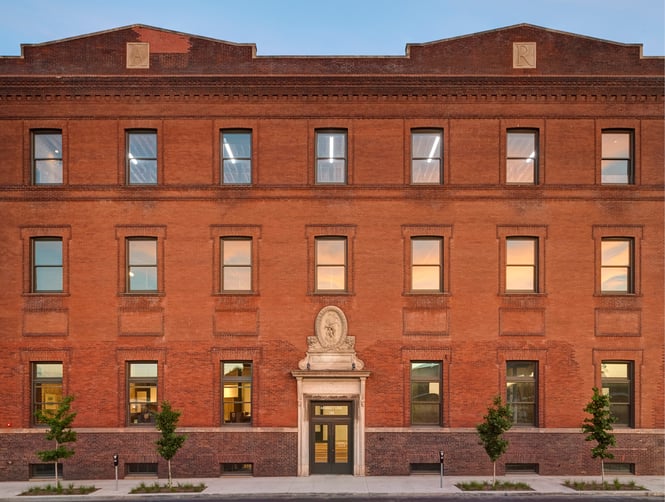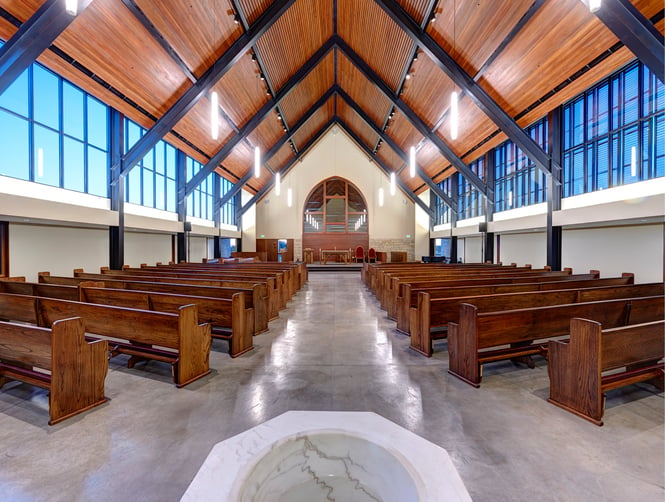Heating and cooling are some of the largest expenses of building ownership—especially for commercial buildings. To reduce long-term costs, it’s important to consider your options and invest in a mechanical system that fits your unique needs.
There are many mechanical systems on the market, including:
- Variable Air Volume (VAV) rooftop units
- Boiler/chiller systems
- Variant Refrigerant Flow (VRF) systems
- Air-source heat pumps
- Ground-source heat pumps
While some systems have a high initial cost, they offer a return on investment through energy savings and reduced maintenance costs. Working with a mechanical engineer, your architect will analyze life cycle costs and help you weigh your options.
In our experience, there is no one-size-fits-all approach to mechanical systems. The most cost-effective option depends on your building’s size and use. The article will discuss the five most common mechanical systems and some factors that impact their efficiency.
Common Mechanical Systems
1. Variable Air Volume (VAV) Rooftop Units
VAV systems are one of the most traditional types of mechanical systems. They are self-contained units, usually located on the roof of commercial and large residential properties. Connected to ductwork, they condition fresh air and cycle it through the building.
Although traditionally used for cooling, many rooftop units have a heating component. In heating mode, air blows over gas-fired or electric coils before cycling through the building.
VAV systems have the lowest initial cost, but long-term costs depend on the unit’s efficiency. Generally, the greater the efficiency of a rooftop unit, the higher the initial cost.
Traditionally, the heating components use natural gas, making VAV systems less sustainable than other options. Electrifying the system is one way to reduce your carbon footprint, though its efficiency will depend on your building type and size.
2. Boiler/Chiller Systems
Boiler/chiller systems are another popular option with large commercial and residential properties. These systems are hydronic, meaning they use water rather than forced air. Water moves through different air handlers to either remove or transfer heat.
Generally, boiler/chiller systems are more efficient than VAV options. They also allow multiple mechanical zones (thermostats in different areas) to heat and cool a building simultaneously.
While more efficient, these systems often come with a higher initial cost. Additionally, they often rely on natural gas, increasing carbon emissions.
3. Variant Refrigerant Flow (VRF) Systems
As the name suggests, VRF systems use refrigerants for heating and cooling. The refrigerant moves through pipes, an innovation that makes them more efficient than forced air systems. Ductwork is still necessary for fresh air requirements, but it is much smaller and has lower fan requirements than a VAV system.
VRF systems fit a variety of applications, including large commercial and smaller residential properties. Their ability to heat and cool with smaller ducts makes them popular with adaptive reuse and historic renovation projects. Market One in Des Moines, for example, used a VRF system to comply with federal historic tax credit requirements.
VRF systems tend to have a higher initial cost than VAV and boiler/chiller systems. However, their efficiency can provide a return on investment through energy savings. They also do not rely on natural gas or other fossil fuels, making them a more sustainable option.

Market One uses a VRF system to meet historic tax credit requirements.
4. Air-Source Heat Pumps
A heat pump is a device that uses a small amount of energy to transfer heat from one location to another. In heating mode, they pull heat from the outside and transfer it into the building. The process can also be reversed for cooling.
Heat pumps are some of the most efficient systems available because they transfer heat, rather than burn fuel to create it.
However, heat pumps are at the higher end of the spectrum in terms of initial costs and may not fit everyone’s budget. Air-sourced systems also work best in more temperate climates. If you experience more drastic seasonal changes, you may need a supplemental heating system or explore the use of a ground-source heat pump.
5. Ground-Source Heat Pumps
Ground-source heat pumps use the same principles as air-sourced systems but rely on geothermal heat. They utilize the earth’s relatively stable temperature to heat and cool a building throughout the seasons.
Of the five systems discussed here, ground-source heat pumps are among the most efficient and sustainable. However, they often require additional on-site equipment installation, increasing the initial cost. Geothermal energy is often regulated by the Department of Natural Resources, and you will need to determine the local restrictions before planning this approach.
Factors that Impact a Mechanical System’s Efficiency
Generally, systems with higher initial costs preset lower life cycle costs and offer a return on investment. While air-sourced and ground-source heat pumps are the most efficient and sustainable options, their effectiveness depends on the building’s size and use.
For example, heat pump systems work well in buildings with some temperature fluctuation. Laboratories or data centers may need to maintain a consistently cool temperature year-round. A heat pump system would require a significantly larger field, increasing the initial costs. In this situation, a VRF system may make more sense when comparing the life cycle and operational costs.
Occupancy requirements and thermal comfort also factor into the equation. Some energy-efficient systems may not adequately cool the building during high occupancy levels.
Churches, for example, experience large occupancy fluctuations. While occupancy numbers are high on Sundays, fewer people use the building throughout the week.
In these situations, a combined system may be the most effective solution. A ground-source heat pump can act as the primary mechanical system during the week, and when occupancy numbers are higher, parishioners can turn on a VAV unit to cool the sanctuary.
In short, energy efficiency is only one factor to consider when choosing a mechanical system. An architect and mechanical engineer can help you weigh your options and find the most cost-effective option for your needs.

Combined systems work well for buildings with varying occupancy numbers.
Other Investments that Improve Building Performance
Choosing a mechanical system is one of the most important steps during a building project. Your choice impacts your operational budget and carbon footprint for years to come. Although efficient systems like heat pumps and VRF systems may come with a higher initial cost, you will likely see a return on investment through energy savings.
The efficiency of these systems depends on several factors, including your building size, its use, and your local climate. Your architect and engineer can analyze these factors and break down life cycle costs.
A mechanical system is just one investment you can make during a building project. Learn more by reading about seven investments that improve building performance.
